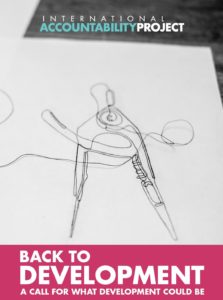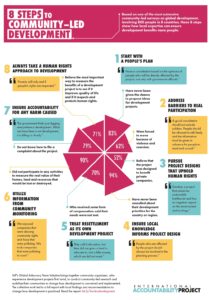Global Advocacy Team: Concept Note
”Ending poverty should come from communities. They should not impose projects but should hear what communities think would end their poverty.”
– community member interviewed by the Global Advocacy Team
Introduction
Today’s prevailing development model is broken – or it has never really worked.

As IAP and our partners have witnessed again and again, those designing, implementing and leading development still fail to meaningfully involve the people whose lives, homes, livelihoods and environment are most impacted. Development projects and programs repeatedly cause harm and often leave communities worse off than before.
To achieve the promises of real development, communities must be recognized as experts and leaders. IAP believes communities have the knowledge and expertise to determine their own development priorities. To that effect, IAP convened the first Global Advocacy Team to document community-level expertise and challenge the existing development model with community-led research and recommendations.
In 2015, the first Global Advocacy Team called for a return to the right to development, and its promise to improve the lives of all people. Drawing from one of the largest community-led surveys on global development, involving 800 people in 8 countries, the findings of the first Global Advocacy Team report Back to Development — A Call For What Development Could Be showed how local expertise can change today’s development policy and practice for the better.
From around the world, 1000 people contributed to make this report a reality. Over 2,000 physical copies of the report (Arabic, English, Spanish) have been distributed and the report has been downloaded or viewed more than 12,000 times. The report directly influenced the World Bank Safeguards Review Process and the Global Advocacy Team was recognized collectively as finalists for the United Nations Equator Prize.
Based on the work of the Global Advocacy Team and others, IAP created three guides on conducting community-led research in the context of development and produced 8 global recommendations to achieving community-led development. The first Global Advocacy Team ended their research by asking the question, “What if development were designed and lived by the same people?”
In this next iteration of the Global Advocacy Team, we would like to find out.

Towards Community-Led Development
A community-led development plan determines or strengthens a community’s own development priorities and improves their participation in the decisions-making which affects their lives and livelihood.
IAP’s Strategic Plan 2020-2025 resulted from surveys and consultations with partners and allies to evaluate its existing programmatic work and determine the organization’s next priorities. As a result of these conversations, the International Accountability Project will assemble a global collective of 8 community organizers to receive training and support to produce their own community-led development plans. As representatives of a community, the Global Advocacy Team members will have a demonstrated commitment to organize and create community-led development plans and an openness to learn from each other’s experience and expertise. A Global Advocacy Team member may be already resisting a proposed or existing project or have the desire to establish their own development priorities independently.
After community-led development plans are created, the Global Advocacy Team will publish a self-written report detailing their creation process and provide recommendations on how the plans can lead decision-making. Based on the research and recommendations of the Global Advocacy Team and other experts, IAP and partners will produce accessible training materials, Community Action Guides, to assist community organizers around the world who wish to start or improve their own community-led development planning. IAP will support the publication and distribution of the Global Advocacy Team report, the training materials and case studies that will emerge from this initiative.
The Global Advocacy Team will demonstrate what the actual fulfillment of the human right to development could be. Their work will be grounded in the interdependent civil, political, economic, social and cultural rights prerequisite to the fulfillment of the right to development, including but not limited to the right to access information, freedom of assembly and association, a healthy environment, education and cultural respect.
Global Advocacy Team Three Year Plan
During the 3 years of the Global Advocacy Team initiative, IAP will equip and amplify the expertise of a global team of community organizers to realize their communities’ visions for community-led development.
Goals
-
- A global team of community organizers and leaders in community-led development are brought together and supported with trainings, organizing and advocacy via the Global Advocacy Team.
- Communities are recognized as decision-makers in development and community-led development plans are organized, created and implemented.
- Funders, governments and relevant decision-makers recognize community-led development as an alternative to today’s development model.
Activities
Year 1
- Convene an in-person experts meeting of community organizers and other experts from around the world to exchange knowledge and materials on community-led development planning.
Output 1: Expert Meeting Report: case studies, resources and recommendations
-
- Recruit an 8-member Global Advocacy Team of community organizers who are creating or would like to create a community-led development plan. Candidates from underrepresented and marginalized groups will be prioritized.
- Host a training for the Global Advocacy Team members to learn how to organize and create their own community-led development plans.
- After the training, over a 6-month period, IAP will support the Global Advocacy Team members to conduct community-led research and determine the development priorities for communities.
Output 2: Global Advocacy Team produces 8 community-led development plans
-
- With community-led research from 8 countries, identify advocacy opportunities to encourage development actors to integrate community-led development planning models more widely.
Year 2
- Review the community-led research results and individual development plans collectively with the Global Advocacy Team to share insights and advice.
- Based on the advocacy strategy set by the Global Advocacy Team, IAP and partners will facilitate opportunities with relevant decision-makers, including governments, development finance institutions, private investors, companies and the human rights bodies, to share the individual and collective results of the community-led research and development plans.
- Publish the Global Advocacy Team report, written by members, describing the community-led development planning process, the results of their community-led research and collective recommendations to further the practice and acceptance of community-led development planning.
Output 3: Global Advocacy Team report
-
- With the report and recommendations, advocate for community-led development to be recognized as a viable alternative. Advocacy will be directed to key influencers within civil society, social movements, governments, development finance institutions, private investors, companies and human rights bodies.
Year 3
- Continue the advocacy campaign as set out by the Global Advocacy Team to advance community-led development models as a viable alternative with key decision-makers.
- Based on the experience of the Global Advocacy Team in creating their own development plans, increase the ability of communities to organize and create community-led development plans by publishing new, accessible Community Action Guide materials:
Output 4: A Guide to Creating Your Own Community-Led Development Plan
Output 5: Case Studies of Communities Leading the Way
-
- Evaluate the Global Advocacy Team initiative by soliciting input from communities, partners, donors and the Global Advocacy Team members and publish the results.
Output 6: Evaluation of the Global Advocacy Team initiative
Support the Next Global Advocacy Team
IAP’s Global Advocacy Team initiative brings together incredible community organizers from around the world to conduct community-led research and mobilize their communities to change how development is designed, funded and implemented.
IAP typically collaborates with people and organizations who are deeply connected with and dependent upon land and natural resources for the life, livelihood, belief system, culture and history. In order to take this initiative forward, we ask funders, partners and allies that work or are interested in working with community-led development to contact us. Your experiences, ideas and proposals are necessary for us to move towards true development. Catch up on Global Advocacy Team news and consider getting involved by emailing us at iap (at) accountabilityproject.org.

